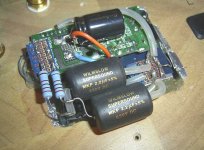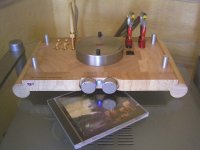assuming the source does not have dc components, is it possible to replace the input coupling capacitor with a wire?
Wire?
This question gets asked all the time. Let me try to make it clear. The input opamp of the Tripath chip runs at a Vcc of +5volts and is grounded for the 2nd voltage. The correct operating point for the input circuit is ½ Vcc which means it is operated at 2.5v above ground. If you short the cap out the chip won’t work as the input circuit is now referenced to ground. In order to make a higher quality off board cap work, the on board one is shorted out and the input to ground resistor is removed (If there is one as on the SI). Its equivalent is now placed across the input RCA connector, anything from 100k to 1meg will be ok. Now a 2.2uf cap can be connected from the RCA hot pin to the circuit board input pin. This circuit can not be directly DC coupled and still work with out some form of circuit to set the correct input voltage! It certainly is not worth the effort to do this when a cap does a fine job. If you have DC coupled it with no other cap the chip shuts down with an input overload error flag set. This will not harm the chip and it will work fine when you fix the problem.
Roger
This question gets asked all the time. Let me try to make it clear. The input opamp of the Tripath chip runs at a Vcc of +5volts and is grounded for the 2nd voltage. The correct operating point for the input circuit is ½ Vcc which means it is operated at 2.5v above ground. If you short the cap out the chip won’t work as the input circuit is now referenced to ground. In order to make a higher quality off board cap work, the on board one is shorted out and the input to ground resistor is removed (If there is one as on the SI). Its equivalent is now placed across the input RCA connector, anything from 100k to 1meg will be ok. Now a 2.2uf cap can be connected from the RCA hot pin to the circuit board input pin. This circuit can not be directly DC coupled and still work with out some form of circuit to set the correct input voltage! It certainly is not worth the effort to do this when a cap does a fine job. If you have DC coupled it with no other cap the chip shuts down with an input overload error flag set. This will not harm the chip and it will work fine when you fix the problem.
Roger
thanks for the explanation.
i'm rather late to the class t game. just got a used board that has the ta2020 chip.
guess i'll just replace the cap with something of better quality.
cheers
garbage
i'm rather late to the class t game. just got a used board that has the ta2020 chip.
guess i'll just replace the cap with something of better quality.
cheers
garbage
Hi roger,
and 50kohm would require twice the value or 4.4uf. In this particular case you would use 4.7uf as the nearest standard value
Is this the same as having a 50k Pot across the input?
Are we useing the big Poly' Caps used in crossover cct's as input Caps and must they be directional (polarised) or does it not matter?
Sorry for being so thick!
Barry.
The old book say's..
..that we're the flat round center of the universe around which all revolves. A very uniplanar, primitive, and limited view. Should there not come a time to question the old word?
You say the old book is right.... let's see.
First of all I'm not at sold on this four significant figure thing of yours.
Let's talk about significant(sp) figures 🙂
http://chemed.chem.purdue.edu/genchem/topicreview/bp/ch1/sigfigs.html
Done.
Although I quickly researched this rule of thumb of having four significant figures at all time?
All I found on it was that this was said to be an OK practice in rounding during intermediate steps of the equation.
How does that make any sense when I might be dealing with six sig figs? Personally I'm of the schooling in the link given above on that issue. We're dealing with one significant figure, as I see it.
Anyway I asked you to show me where that 9 came from, you have, and I thank you, but to say it's correct I disagree with, actually what you said was correct to four sig figs, I think I disagree with that too.
What's cut off really?
What my book says:
Also referred to as the "half-power point". The voltage amplitude drops to 70.7%, the current will also drop to 70.7%. Since the power is the product of the voltage times current, the power will drop to 50%. (0.5=.707*.707) The cut off frequency is often described in decibels, (dB). Negative 3 dB is equal to 70.7% using the voltage formula for dB [(dB=20 log (Vx/Vref)] and is equal to 50% using the power formula for dB [(dB=10 log Px/Pref)].
/mybook.
That sums a few posts up nice and clear like.
The fact that information isn't in Roger's old book tells me it's not much of a book, so sure, let's question it.
I think the question of how the "1 / sqrt(2) = 0.707" came to be was asked as well, I'll try and cover everything.
I thought it was explained well enough in the website I'd linked to earlier. I still do, here it is again:
http://www.play-hookey.com/ac_theory/lo_pass_filters.html
You'll note they leave you with 0.707 as an answer to 1 / sqrt(2).
Without rounding we actually have 0.707106781, but nobody is going to be going around saying "we're at the 0.707106781 point", why not say 70.7%, in practice? Works for me. Given it's the very same 1/sqrt2 (.707 that is) we use to convert from peak to rms voltages, I automatically assume it's the more correct number than .7079.
All the same, cut off is actually exactly 10 log(.5) = -3.01029996 for power and 20 log(1/(sqrt2)) = -3.01029996 for amplitude.
20 log(.7079) = -3.00056175 clearly demonstrates the 9 is a factor of having "idealized" cut off to -3, one significant(sp) figure, certainly not because it's exact to four, which would have to be -3.010, and here is your proof of where the 9 comes from, again, just for clarity:
10^(-3 / 20) = 0.707945784
10^(-3.01029996 / 20) = 0.707106781
1 / sqrt(2) = 0.707106781
So we clearly see where the nine comes from, we clearly see it can't be considered correct, unless we're OK with saying it's correct because it's correct to four sig figs, pre based on a rounded approximation of one sig fig. ie. "-3".
So maybe this is why new books have .707 in them instead.
Clearly this is extreeeem nitpicking, and I originally didn't feel the need to re-disagree with the old book being correct or not, but then I thought Roger could use a better book🙂
Cheers,
Chris
..that we're the flat round center of the universe around which all revolves. A very uniplanar, primitive, and limited view. Should there not come a time to question the old word?
You say the old book is right.... let's see.
First of all I'm not at sold on this four significant figure thing of yours.
Let's talk about significant(sp) figures 🙂
http://chemed.chem.purdue.edu/genchem/topicreview/bp/ch1/sigfigs.html
Done.
Although I quickly researched this rule of thumb of having four significant figures at all time?
All I found on it was that this was said to be an OK practice in rounding during intermediate steps of the equation.
How does that make any sense when I might be dealing with six sig figs? Personally I'm of the schooling in the link given above on that issue. We're dealing with one significant figure, as I see it.
Anyway I asked you to show me where that 9 came from, you have, and I thank you, but to say it's correct I disagree with, actually what you said was correct to four sig figs, I think I disagree with that too.
What's cut off really?
What my book says:
Also referred to as the "half-power point". The voltage amplitude drops to 70.7%, the current will also drop to 70.7%. Since the power is the product of the voltage times current, the power will drop to 50%. (0.5=.707*.707) The cut off frequency is often described in decibels, (dB). Negative 3 dB is equal to 70.7% using the voltage formula for dB [(dB=20 log (Vx/Vref)] and is equal to 50% using the power formula for dB [(dB=10 log Px/Pref)].
/mybook.
That sums a few posts up nice and clear like.
The fact that information isn't in Roger's old book tells me it's not much of a book, so sure, let's question it.
I think the question of how the "1 / sqrt(2) = 0.707" came to be was asked as well, I'll try and cover everything.
I thought it was explained well enough in the website I'd linked to earlier. I still do, here it is again:
http://www.play-hookey.com/ac_theory/lo_pass_filters.html
You'll note they leave you with 0.707 as an answer to 1 / sqrt(2).
Without rounding we actually have 0.707106781, but nobody is going to be going around saying "we're at the 0.707106781 point", why not say 70.7%, in practice? Works for me. Given it's the very same 1/sqrt2 (.707 that is) we use to convert from peak to rms voltages, I automatically assume it's the more correct number than .7079.
All the same, cut off is actually exactly 10 log(.5) = -3.01029996 for power and 20 log(1/(sqrt2)) = -3.01029996 for amplitude.
20 log(.7079) = -3.00056175 clearly demonstrates the 9 is a factor of having "idealized" cut off to -3, one significant(sp) figure, certainly not because it's exact to four, which would have to be -3.010, and here is your proof of where the 9 comes from, again, just for clarity:
10^(-3 / 20) = 0.707945784
10^(-3.01029996 / 20) = 0.707106781
1 / sqrt(2) = 0.707106781
So we clearly see where the nine comes from, we clearly see it can't be considered correct, unless we're OK with saying it's correct because it's correct to four sig figs, pre based on a rounded approximation of one sig fig. ie. "-3".
So maybe this is why new books have .707 in them instead.
Clearly this is extreeeem nitpicking, and I originally didn't feel the need to re-disagree with the old book being correct or not, but then I thought Roger could use a better book🙂
Cheers,
Chris
A question of accuracy!
Chris,
Well what can I say, you did it again! It all fits together and makes perfect sense now. I really do need a new handbook.
Thank you,
Roger
Chris,
Well what can I say, you did it again! It all fits together and makes perfect sense now. I really do need a new handbook.
Thank you,
Roger
- Status
- Not open for further replies.
- Home
- Amplifiers
- Class D
- How low can T go?

